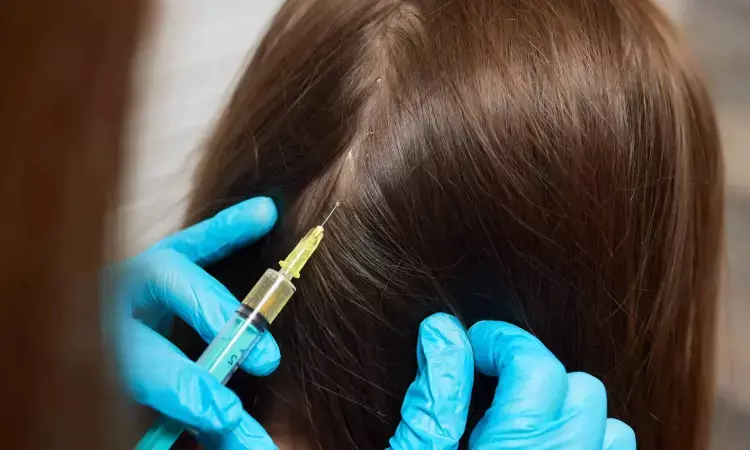- Home
- Medical news & Guidelines
- Anesthesiology
- Cardiology and CTVS
- Critical Care
- Dentistry
- Dermatology
- Diabetes and Endocrinology
- ENT
- Gastroenterology
- Medicine
- Nephrology
- Neurology
- Obstretics-Gynaecology
- Oncology
- Ophthalmology
- Orthopaedics
- Pediatrics-Neonatology
- Psychiatry
- Pulmonology
- Radiology
- Surgery
- Urology
- Laboratory Medicine
- Diet
- Nursing
- Paramedical
- Physiotherapy
- Health news
- Fact Check
- Bone Health Fact Check
- Brain Health Fact Check
- Cancer Related Fact Check
- Child Care Fact Check
- Dental and oral health fact check
- Diabetes and metabolic health fact check
- Diet and Nutrition Fact Check
- Eye and ENT Care Fact Check
- Fitness fact check
- Gut health fact check
- Heart health fact check
- Kidney health fact check
- Medical education fact check
- Men's health fact check
- Respiratory fact check
- Skin and hair care fact check
- Vaccine and Immunization fact check
- Women's health fact check
- AYUSH
- State News
- Andaman and Nicobar Islands
- Andhra Pradesh
- Arunachal Pradesh
- Assam
- Bihar
- Chandigarh
- Chattisgarh
- Dadra and Nagar Haveli
- Daman and Diu
- Delhi
- Goa
- Gujarat
- Haryana
- Himachal Pradesh
- Jammu & Kashmir
- Jharkhand
- Karnataka
- Kerala
- Ladakh
- Lakshadweep
- Madhya Pradesh
- Maharashtra
- Manipur
- Meghalaya
- Mizoram
- Nagaland
- Odisha
- Puducherry
- Punjab
- Rajasthan
- Sikkim
- Tamil Nadu
- Telangana
- Tripura
- Uttar Pradesh
- Uttrakhand
- West Bengal
- Medical Education
- Industry
Which is better local anesthesia technique for mesotherapy for Hair Regrowth in the Temporal Region?

Recently published research paper investigates the efficacy of mesotherapy for hair regrowth in the temporal region, specifically focusing on the use of platelet-rich plasma (PRP) and vitamins. The injection techniques for mesotherapy involve the administration of zygomaticotemporal nerve blocks, supratrochlear nerve blocks, and supraorbital nerve blocks. The study conducted a comparative analysis of two different local anesthesia techniques for mesotherapy and found that the use of zygomaticotemporal nerve blocks, in addition to supratrochlear and supraorbital nerve blocks, resulted in better pain control and reduction during and after the procedure.
“Comparative Study on Pain Control”
The researchers conducted a prospective comparative study with 100 participants divided into two groups (group I and group II). Group I received zygomaticotemporal, supratrochlear, and supraorbital nerve blocks, while group II received supratrochlear and supraorbital nerve blocks. The pain was assessed using a visual analog scale (VAS), and the study found that group I experienced significantly less pain during and after the procedure compared to group II.
History and Development of Mesotherapy”
The paper discusses the history and development of mesotherapy as a minimally invasive medical procedure for a wide range of medical and cosmetic issues, including hair regrowth. It elaborates on the technique of mesotherapy, which involves injecting a mixture of vitamins, minerals, amino acids, and pharmaceutical and homeopathic remedies directly into the middle layer of the skin to promote cellular regeneration and therapeutic benefits.
“Findings of Zygomaticotemporal Nerve Blocks”
The findings of the study demonstrated that the addition of zygomaticotemporal nerve blocks to supratrochlear and supraorbital nerve blocks resulted in better pain control during PRP mesotherapy in the temporal region. The paper also discusses the potential broader applications of zygomaticotemporal blocks in other medical procedures and the importance of further research in this area. It concludes by emphasizing the need for larger sample sizes and diverse injection technique comparisons to enhance the understanding of mesotherapy.
Efficacy of Mesotherapy for Hair Regrowth
In conclusion, the paper provides detailed insights into the efficacy of mesotherapy for hair regrowth in the temporal region, specifically focusing on the use of different nerve blocks for local anesthesia techniques. It underscores the importance of zygomaticotemporal nerve blocks in enhancing pain control during PRP mesotherapy and highlights the potential applications of this technique in other medical procedures. The study's findings contribute to the understanding of mesotherapy and its potential for treating alopecia in the temporal region.
Key Points
1. The paper investigates the efficacy of mesotherapy for hair regrowth in the temporal region, specifically focusing on the use of platelet-rich plasma (PRP) and vitamins. It discusses injection techniques for mesotherapy, which involve the administration of zygomaticotemporal nerve blocks, supratrochlear nerve blocks, and supraorbital nerve blocks. The study found that the use of zygomaticotemporal nerve blocks, in addition to supratrochlear and supraorbital nerve blocks, resulted in better pain control and reduction during and after the procedure.
2. The researchers conducted a prospective comparative study with 100 participants divided into two groups. Group I received zygomaticotemporal, supratrochlear, and supraorbital nerve blocks, while group II received only supratrochlear and supraorbital nerve blocks. The pain was assessed using a visual analog scale (VAS), and it was found that group I experienced significantly less pain during and after the procedure compared to group II. This comparative study emphasized the advantage of using zygomaticotemporal nerve blocks in enhancing pain control during mesotherapy.
The paper provides detailed insights into the efficacy of mesotherapy for hair regrowth in the temporal region, focusing on the use of different nerve blocks for local anesthesia techniques, and underscores the importance of zygomaticotemporal nerve blocks in enhancing pain control during PRP mesotherapy.
Reference-
Nagaja S A, John R S, Kumar S P, et al. (April 17, 2024) Comparison of the Efficacy of Two Different Local Anesthesia Techniques for Mesotherapy in Temporal Region Alopecia. Cureus 16(4): e58498. DOI 10.7759/cureus.58498
MBBS, MD (Anaesthesiology), FNB (Cardiac Anaesthesiology)
Dr Monish Raut is a practicing Cardiac Anesthesiologist. He completed his MBBS at Government Medical College, Nagpur, and pursued his MD in Anesthesiology at BJ Medical College, Pune. Further specializing in Cardiac Anesthesiology, Dr Raut earned his FNB in Cardiac Anesthesiology from Sir Ganga Ram Hospital, Delhi.


